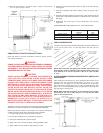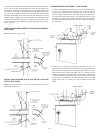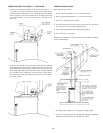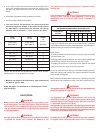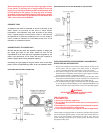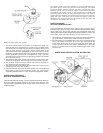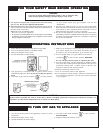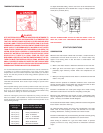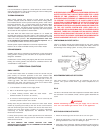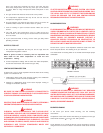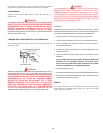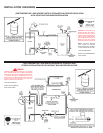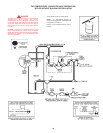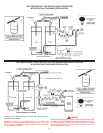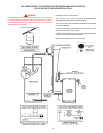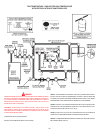
25
SMOKE/ODOR
It is not uncommon to experience a small amount of smoke and odor
during the initial start-up. This is due to burning off of oil from metal parts,
and will disappear in a short while.
THERMAL EXPANSION
Water supply systems may, because of such events as high line
pressure, frequent cutoffs, the effects of water hammer among others,
have installed devices such as pressure reducing valves, check valves,
back flow preventers, etc... to control these types of problems. When
these devices are not equipped with an internal by-pass, and no other
measures are taken, the devices cause the water system to be closed.
As water is heated, it expands (thermal expansion) and closed systems
do not allow for the expansion of heated water.
The water within the water heater tank expands as it is heated and
increases the pressure of the water system. If the relieving point of the
water heater’s temperature-pressure relief valve is reached, the valve will
relieve the excess pressure. The temperature-pressure relief valve
is not intended for the constant relief of thermal expansion. This is
an unacceptable condition and must be corrected.
Closed systems require installation of a thermal expansion tank.
Failure to do so voids the limited warranty for this water heater.
STRANGE SOUNDS
Possible noises due to expansion and contraction of some metal parts
during periods of heat-up and cool-down do not represent harmful or
dangerous conditions.
Condensation causes sizzling and popping with the burner area during
heating and cooling periods and should be considered normal. See
“Condensation” in this section.
OPERATIONAL CONDITIONS
SMELLY WATER
In each water heater there is installed at least one anode rod (see
parts section) for corrosion protection of the tank. Certain water
conditions will cause a reaction between this rod and the water. The
most common complaint associated with the anode rod is one of a
“rotten egg smell”. This odor is derived from hydrogen sulfide gas
dissolved in the water. The smell is the result of four factors which
must all be present for the odor to develop:
a. a concentration of sulfate in the supply water.
b. little or no dissolved oxygen in the water.
c. a sulfate reducing bacteria within the water heater. (This
harmless bacteria is non-toxic to humans.)
d. an excess of active hydrogen in the tank. This is caused by the
corrosion protective action of the anode.
Smelly water may be eliminated or reduced in some water heater
models by replacing the anode(s) with one of less active material,
and then chlorinating the water heater tank and all hot water lines.
Contact the local water heater supplier for further information
concerning an Anode Replacement Kit #9000029 and this
Chlorination Treatment.
If smelly water persists after anode replacement and chlorination
treatment, then the water supply must be chlorinated or aerated to
eliminate the bacteria.
DO NOT REMOVE THE ANODE LEAVING THE TANK
UNPROTECTED. BY DOING SO, ALL WARRANTY ON THE WATER
HEATER TANK IS VOIDED.
“AIR” IN HOT WATER FAUCETS
WARNING
HYDROGEN GAS: HYDROGEN GAS CAN BE PRODUCED IN A HOT
WATER SYSTEM THAT HAS NOT BEEN USED FOR A LONG
PERIOD OF TIME (GENERALLY TWO WEEKS OR MORE).
HYDROGEN GAS IS EXTREMELY FLAMMABLE AND EXPLOSIVE.
TO PREVENT THE POSSIBILITY OF INJURY UNDER THESE
CONDITIONS, WE RECOMMEND THE HOT WATER FAUCET BE
OPENED FOR SEVERAL MINUTES AT THE KITCHEN SINK
BEFORE ANY ELECTRICAL APPLIANCES WHICH ARE CONNECTED
TO THE HOT WATER SYSTEM ARE USED (SUCH AS A
DISHWASHER OR WASHING MACHINE). IF HYDROGEN GAS IS
PRESENT, THERE WILL PROBABLY BE AN UNUSUAL SOUND
SIMILAR TO AIR ESCAPING THROUGH THE PIPE AS THE HOT
WATER FAUCET IS OPENED. THERE MUST BE NO SMOKING OR
OPEN FLAME NEAR THE FAUCET AT THE TIME IT IS OPEN.
VENTING MANUAL RESET SWITCH
There is a venting manual reset switch located on top of the venting
hood. If the switch is activated, before resetting the switch, check for
flue blockage in the venting system. To reset, press the red button.
HIGH TEMPERATURE SHUT OFF SYSTEM
This water heater is equipped with an automatic gas shut off
system. This system works when high water temperatures are
present.
E.C.O.
The E.C.O. will activate if the water temperature exceeds 200°F and will
not reset itself. If it is activated, contact a service agent to determine the
cause.
WARNING
Should overheating occur or the gas supply fail to shut off,
turn “off” the manual gas control valve to the appliance.
NOT ENOUGH OR NO HOT WATER
1. Check the manual gas shut off valve to be sure it is open.
2. Check the pilot flame. It may have gone out. All models have an
opening behind the outer door for viewing the pilot.
3. If the pilot is not lit, follow the “Lighting” instructions in this manual or
located above the gas control valve on the water heater to relight the



